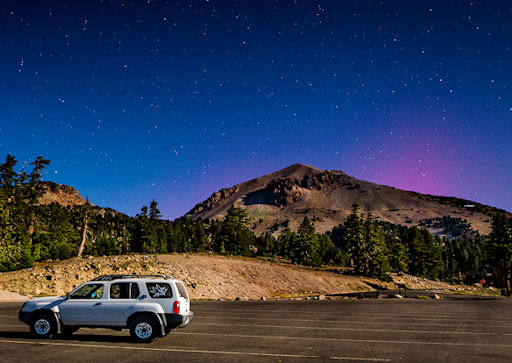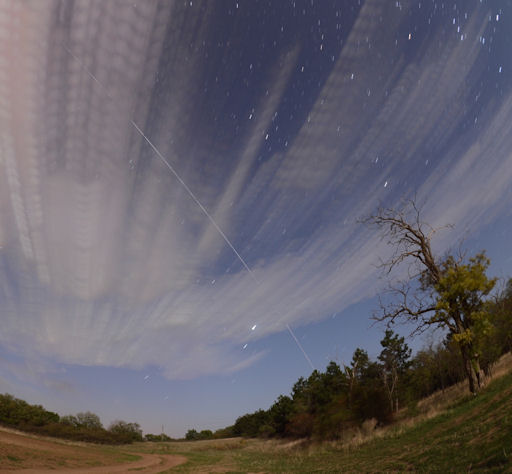SUBSIDING STORM: A strong (Kp=7) geomagnetic storm sparked by a CME impact on Sept. 30th is subsiding now. At maximum, during the early hours of Oct. 1st, Northern Lights descended as far south in the United States as Michigan, Maryland, Pennsylvania, Wisconsin, Ohio, Montana, Minnesota, Washington, Idaho, Illinois and South Dakota. Even California experienced some auroras. Tim Piya Trepetch caught a patch of sky turning purple over the Lassen Volcanic National Park:
"Purple auroras erupted right over Lassen Peak," says Trepetch.
California auroras are not as rare as some people think. The webmaster of spaceweather.com lives in California and has witnessed auroras no fewer than six times. The trick is knowing when to look. Aurora alerts: text, voice.
ISS COMPANION: Europe's massive ATV-3 cargo carrier undocked from the International Space Station (ISS) on Sept. 28th. Now the spacecraft, as large as a double-decker bus, is leading the ISS in orbit around Earth. Monika Landy-Gyebnar saw it this morning flying over Veszprem, Hungary:
"I went outside to see the ISS," says Landy-Gyebnar. "About a minute before the space station appeared, I saw a realtively bright object flying overheads almost where the ISS was to fly. Then I remembered that the ATV-3 undocked from ISS on Friday--and there it was! Just as ATV-3 has faded, the ISS emerged from the clouds and followed the small cargo vehicle towards the east."
The ATV-3 will reenter Earth's atmosphere on or about October 3rd, disintegrating in a spectacular fireball over the Pacific Ocean. Until then, sky watchers should be alert for the cargo vessel leading the ISS across the night sky. ATV-3 and ISS flyby predictions may be found on the web or on your smartphone.

![]()
Solar wind
speed: 367.8 km/sec
density: 0.7 protons/cm3
explanation | more data
Updated: Today at 1637 UT
![]()
X-ray Solar Flares
6-hr max: C4 1313 UT Oct01
24-hr: C4 1313 UT Oct01
explanation | more data
Updated: Today at: 1559 UT
![]()
![]()
![]()
Daily Sun: 01 Oct 12
![]()
![]()
Departing sunspot 1583 poses a threat for M-class solar flares, not Earth-directed. Credit: SDO/HMI
![]()
![]()
![]()
Sunspot number: 95
What is the sunspot number?
Updated 01 Oct 2012
Spotless Days
Current Stretch: 0 days
2012 total: 0 days (0%)
2011 total: 2 days (<1%)
2010 total: 51 days (14%)
2009 total: 260 days (71%)
Since 2004: 821 days
Typical Solar Min: 486 days
Update 01 Oct 2012
The Radio Sun
10.7 cm flux: 136sfu
explanation | more data
Updated 01 Oct 2012
![]()
![]()
![]()
Current Auroral Oval:
![]()
Switch to: Europe, USA, New Zealand, Antarctica
Credit: NOAA/POES
![]()
![]()
![]()
Planetary K-index
Now: Kp= 3 quiet
24-hr max: Kp= 7 strong
explanation | more data
![]()
Interplanetary Mag. Field
Btotal: 9.0 nT
Bz: 8.0 nT north
explanation | more data
Updated: Today at 1636 UT
![]()
![]()
![]()
Coronal Holes: 01 Oct 12
![]()
![]()
There are no large coronal holes on the Earth side of the sun. Credit: SDO/AIA.






